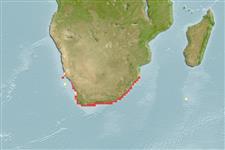Environment: milieu / climate zone / depth range / distribution range
Écologie
marin; eau douce; saumâtre. Subtropical; 27°S - 35°S
Southeast Atlantic: restricted from Lüderitz, Namibia to northern Natal, South Africa.
Length at first maturity / Taille / Poids / Âge
Maturity: Lm 4.0 range ? - ? cm
Max length : 11.0 cm SL mâle / non sexé; (Ref. 7248)
Épines dorsales (Total) : 6 - 9; Rayons mous dorsaux (Total) : 11 - 15; Épines anales: 1; Rayons mous anaux: 15 - 18. Body silvery and translucent with a midlateral band; dusky upper surface (Ref. 4125).
Forms schools along the coast and in estuaries, especially during spring (Ref. 3302). Also found in coastal lakes (Ref. 7248). Small individuals filter out small organisms such as phytoplankton and rotifers. Above 3.5 cm TL, it feeds mostly on crustaceans especially amphipods taken from the water column as well as off the bottom. Preyed upon by fishes and birds (Ref. 7248).
Life cycle and mating behavior
Maturities | Reproduction | Spawnings | Egg(s) | Fecundities | Larves
Skelton, P.H., 1993. A complete guide to the freshwater fishes of southern Africa. Southern Book Publishers. 388 p. (Ref. 7248)
Statut dans la liste rouge de l'IUCN (Ref. 130435)
Menace pour l'homme
Harmless
Utilisations par l'homme
Pêcheries: pêcheries vivrières; appât: usually
Outils
Articles particuliers
Télécharger en XML
Sources Internet
Estimates based on models
Preferred temperature (Ref.
123201): 14.3 - 23.9, mean 19.5 °C (based on 14 cells).
Phylogenetic diversity index (Ref.
82804): PD
50 = 0.5312 [Uniqueness, from 0.5 = low to 2.0 = high].
Bayesian length-weight: a=0.00776 (0.00426 - 0.01415), b=3.14 (2.97 - 3.31), in cm total length, based on LWR estimates for this species & (Sub)family-body (Ref.
93245).
Niveau trophique (Ref.
69278): 3.4 ±0.46 se; based on food items.
Résilience (Ref.
120179): Milieu, temps minimum de doublement de population : 1,4 à 4,4 années (Preliminary K or Fecundity.).
Fishing Vulnerability (Ref.
59153): Low vulnerability (10 of 100).
